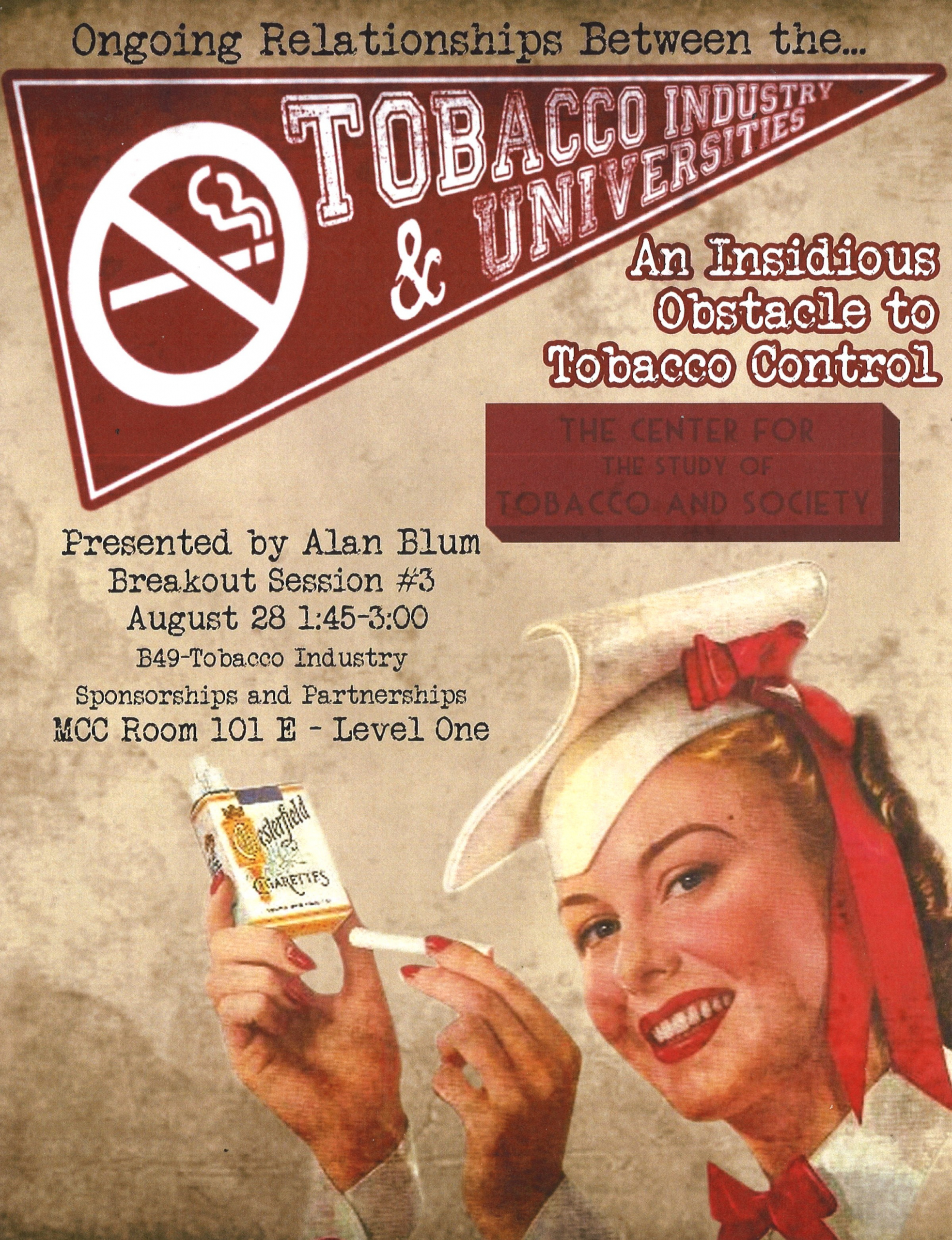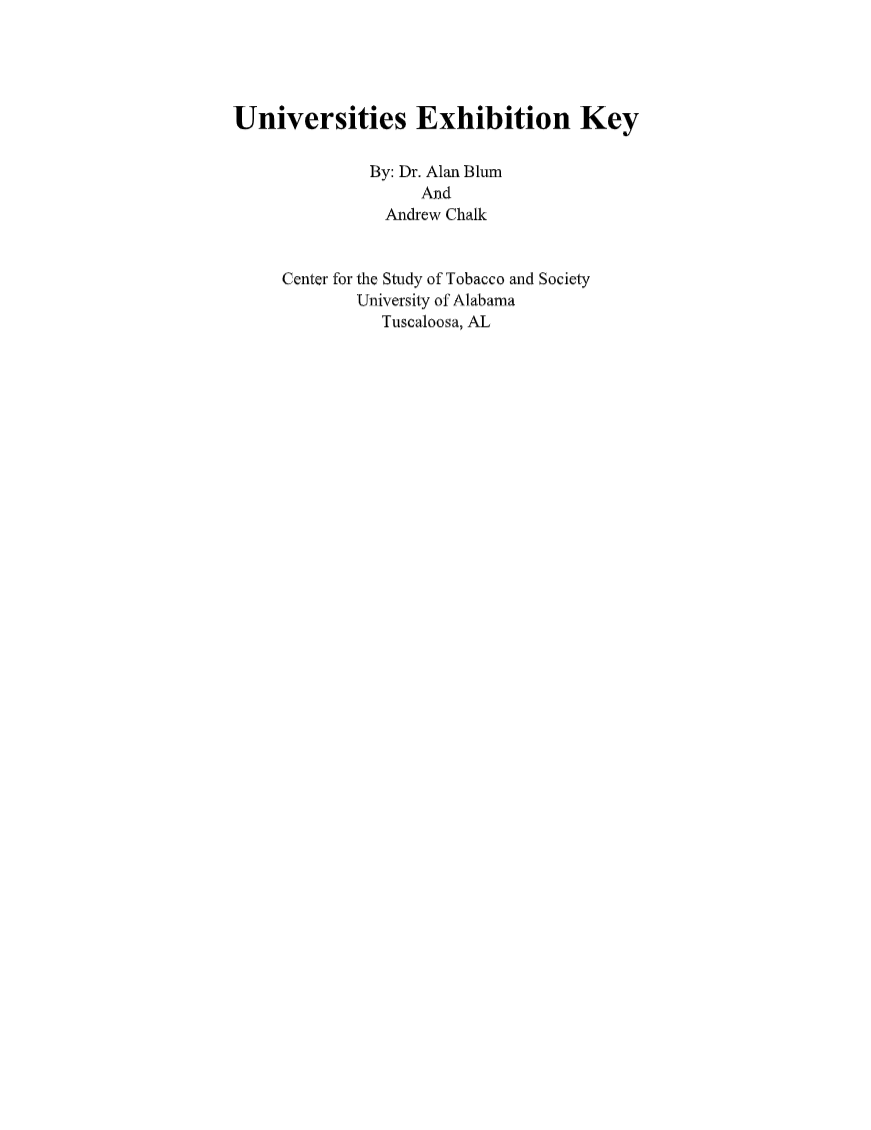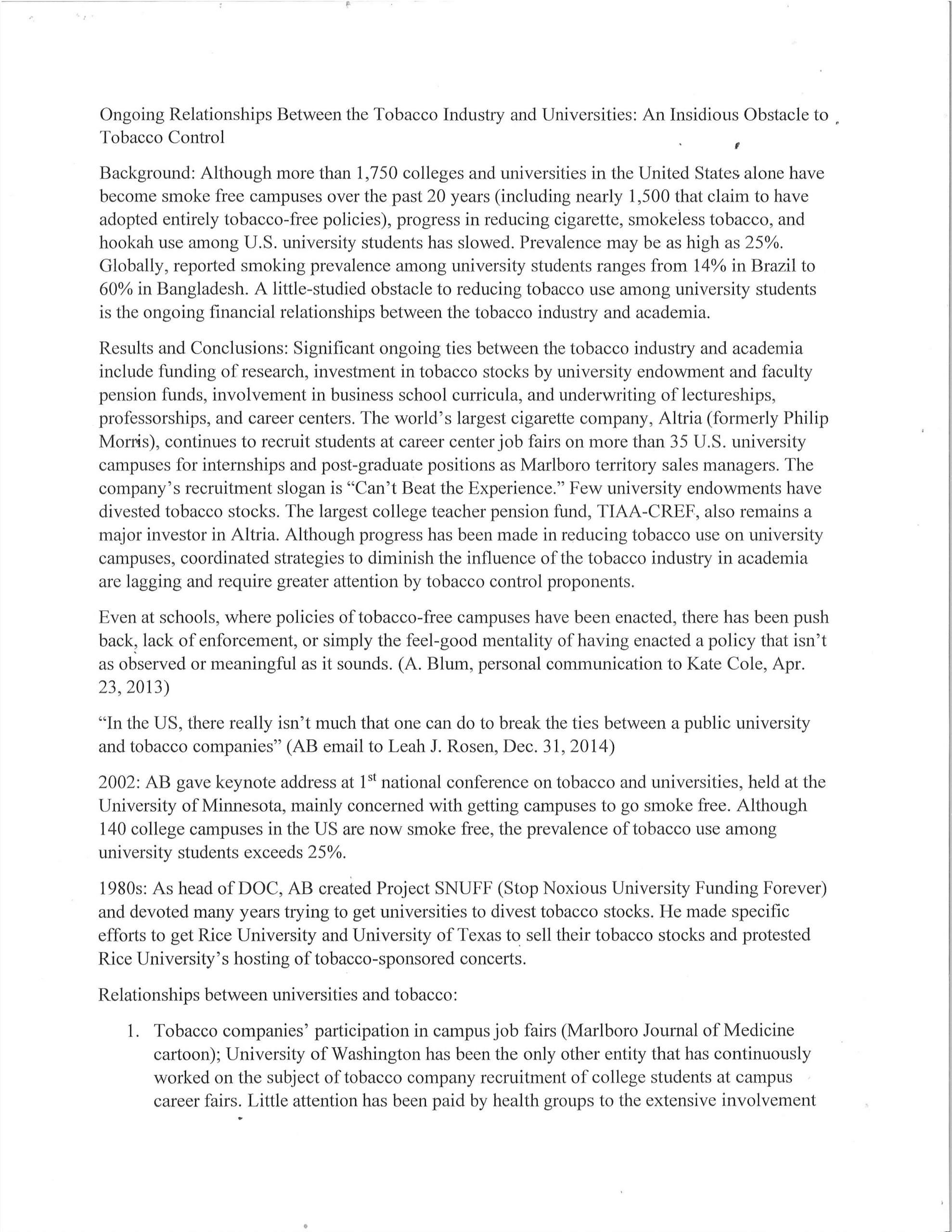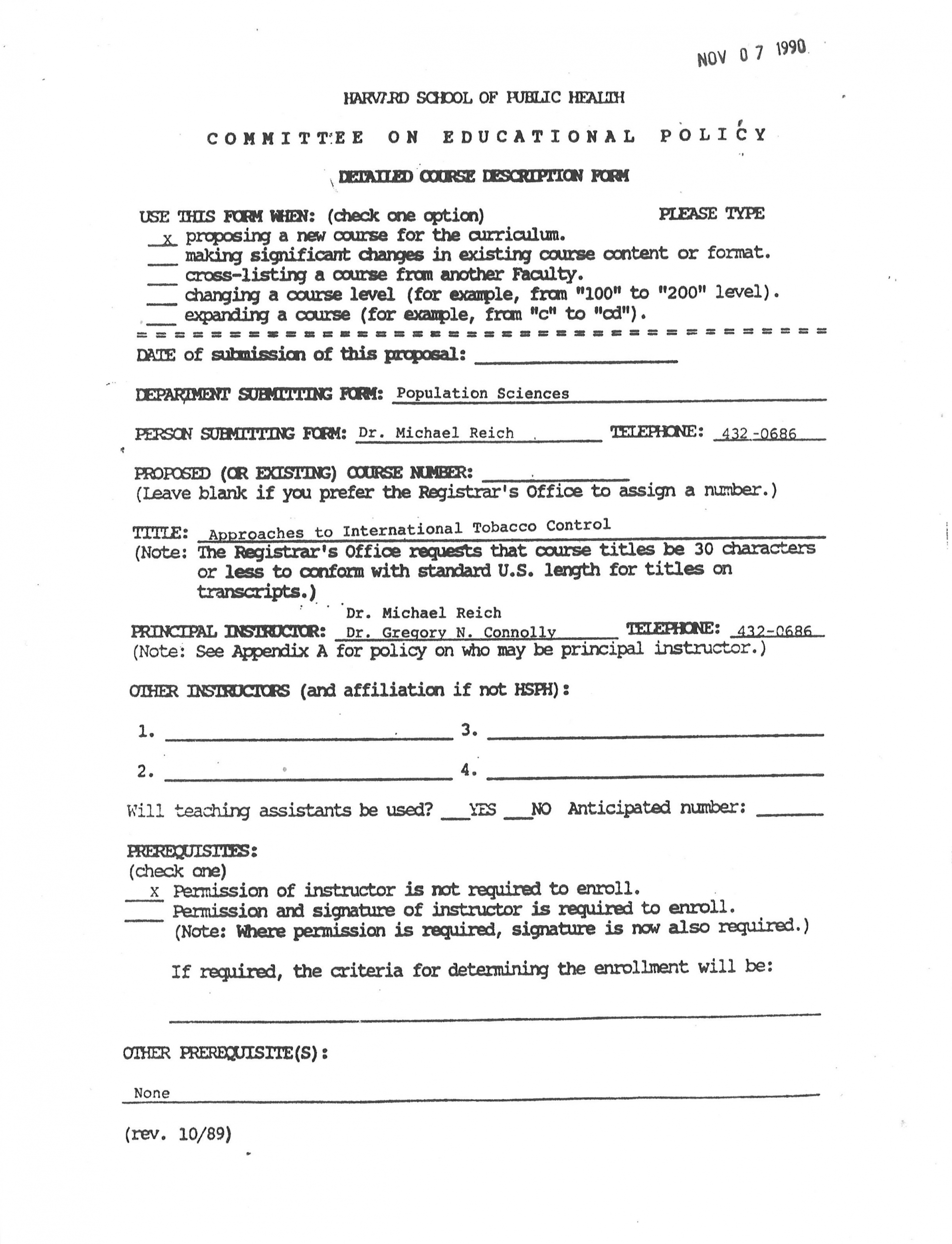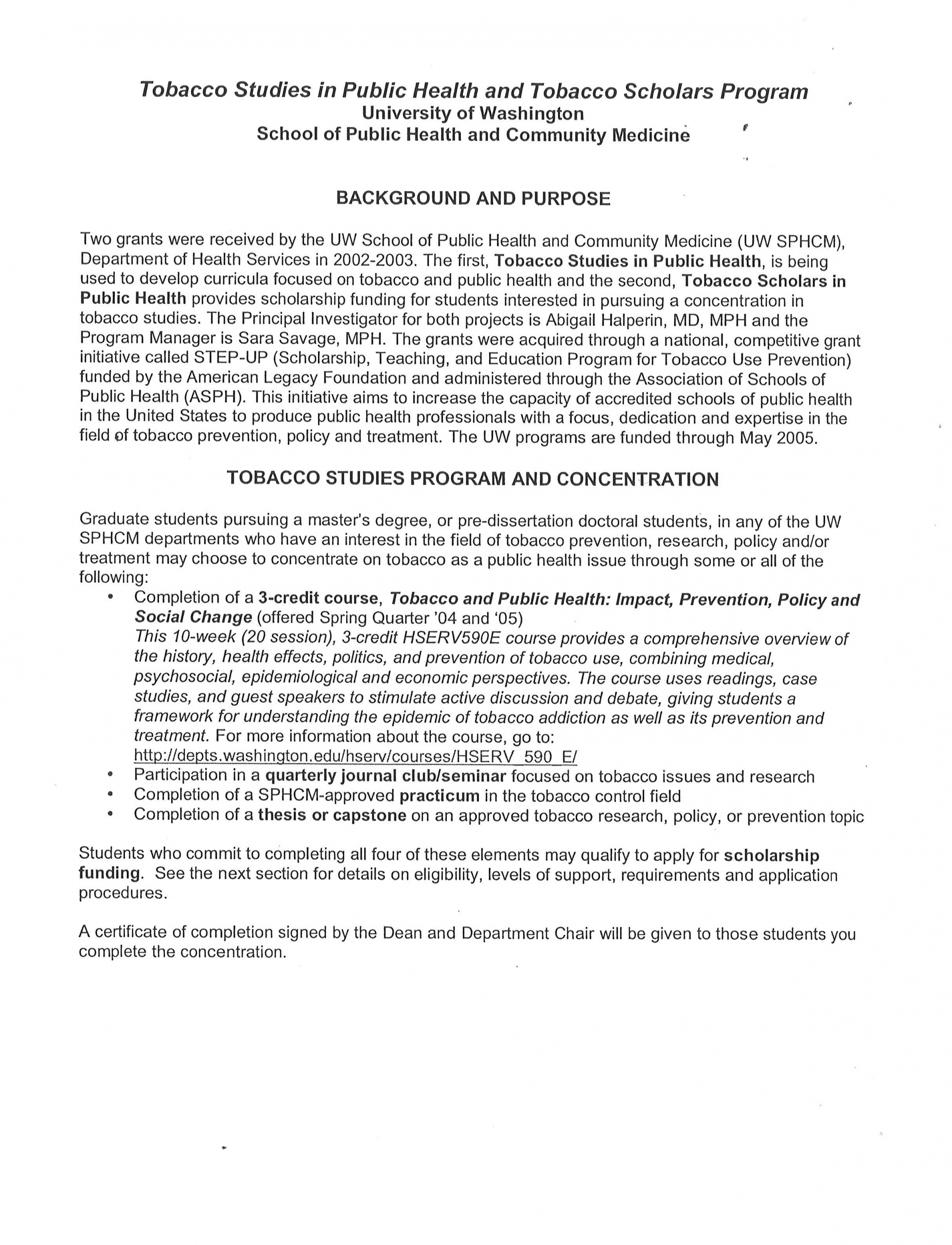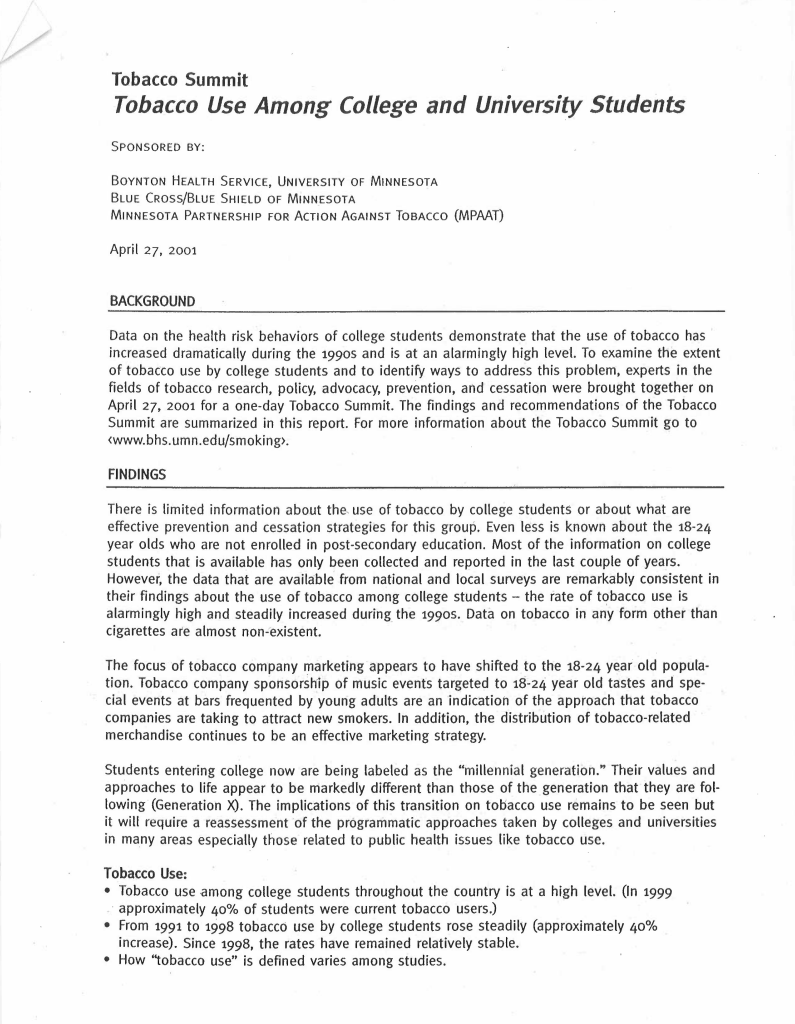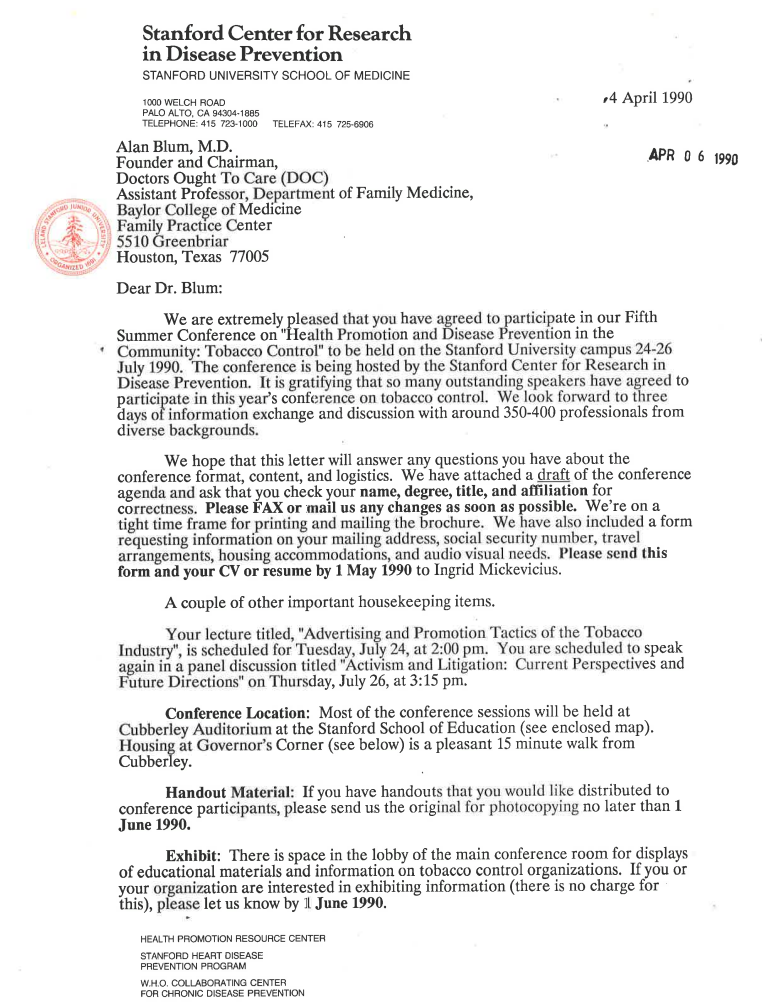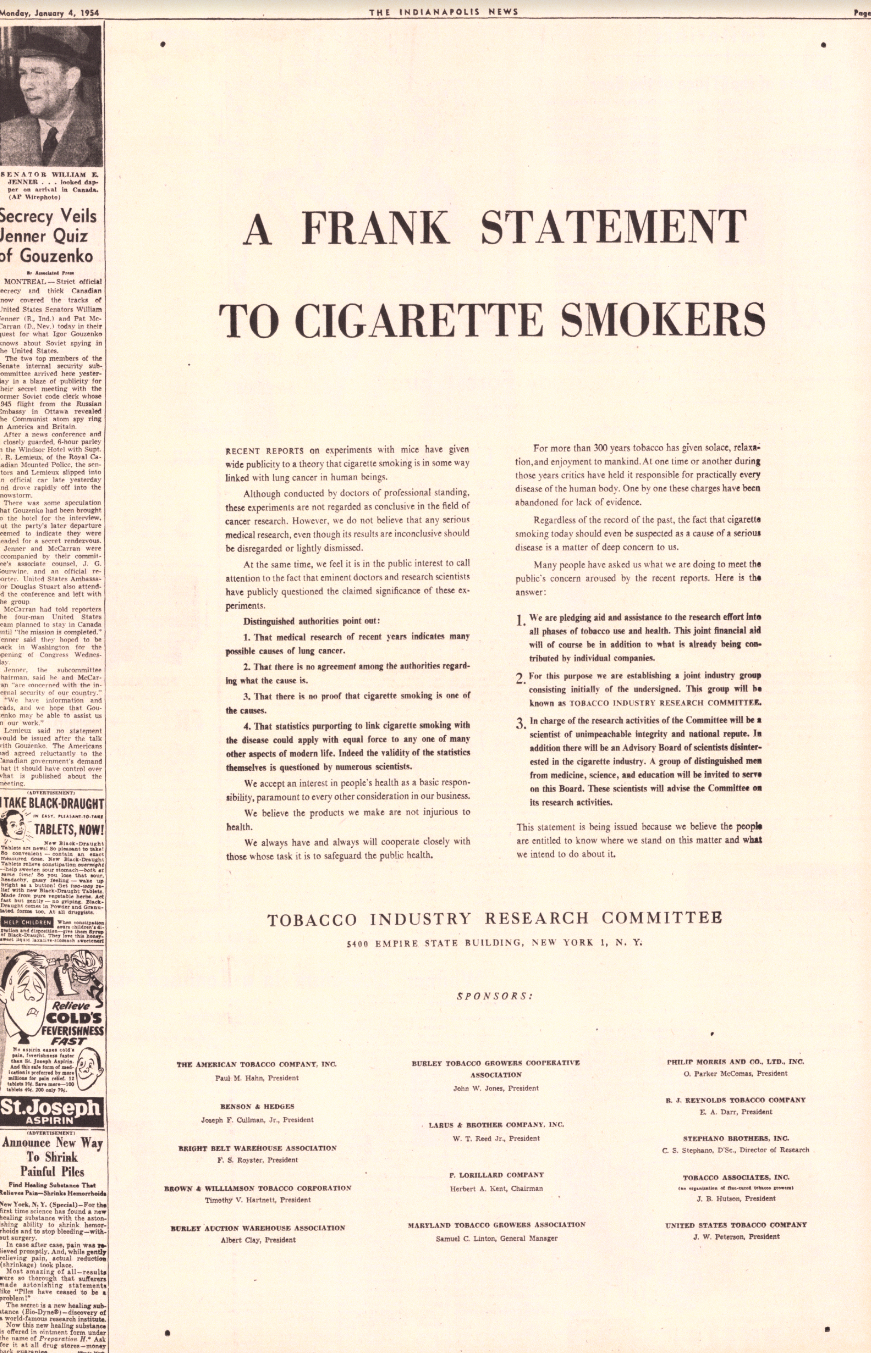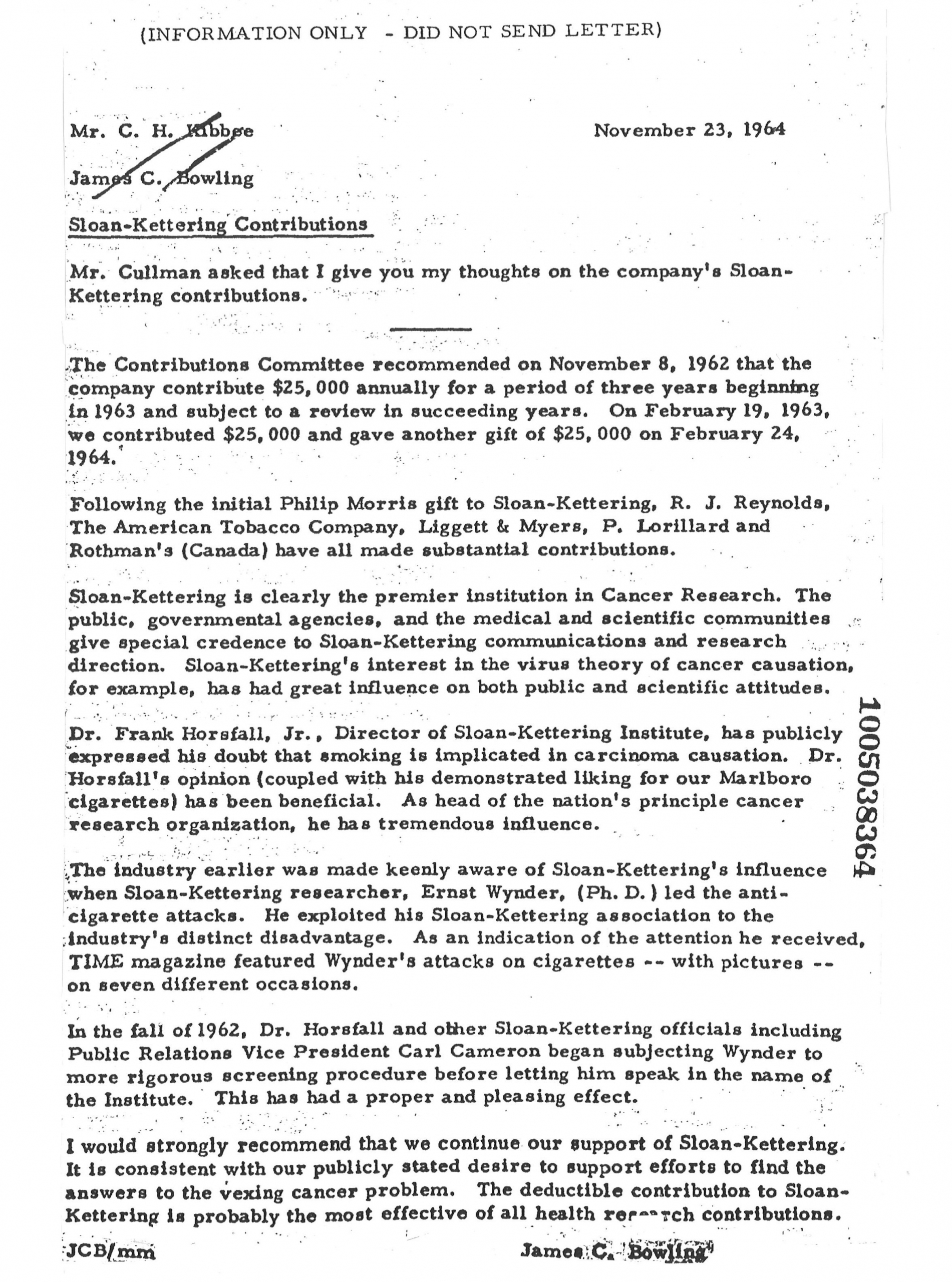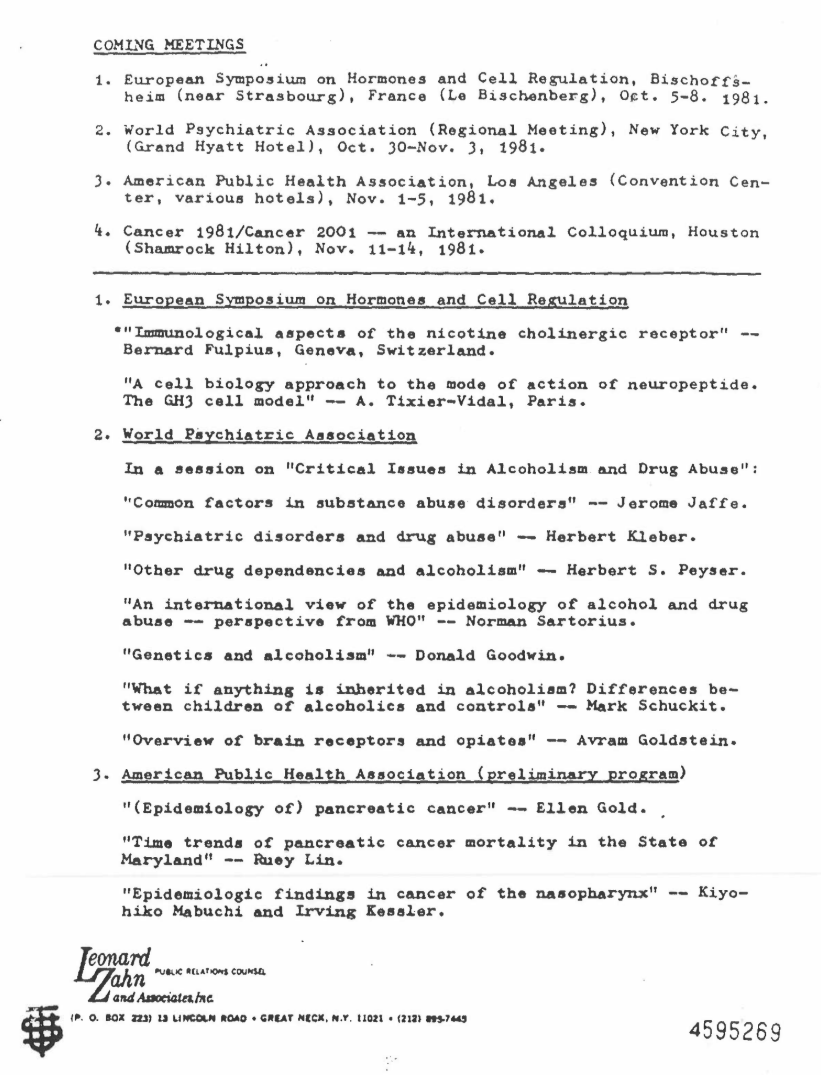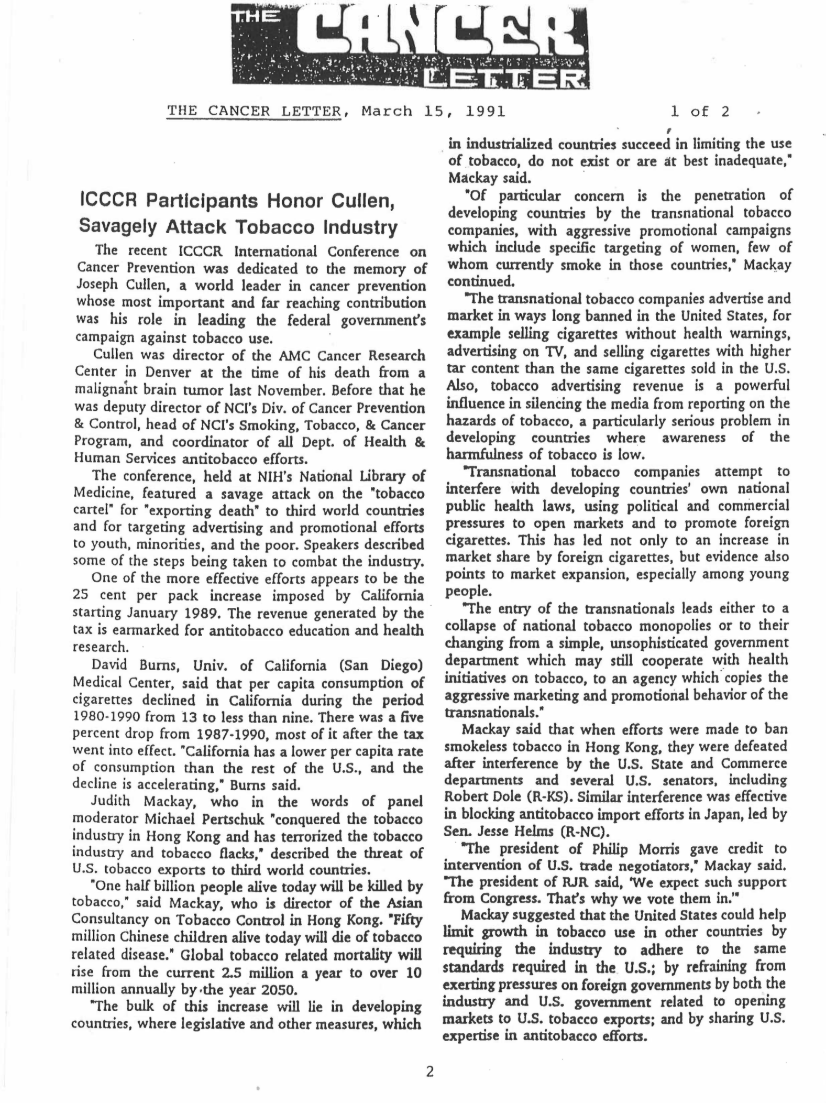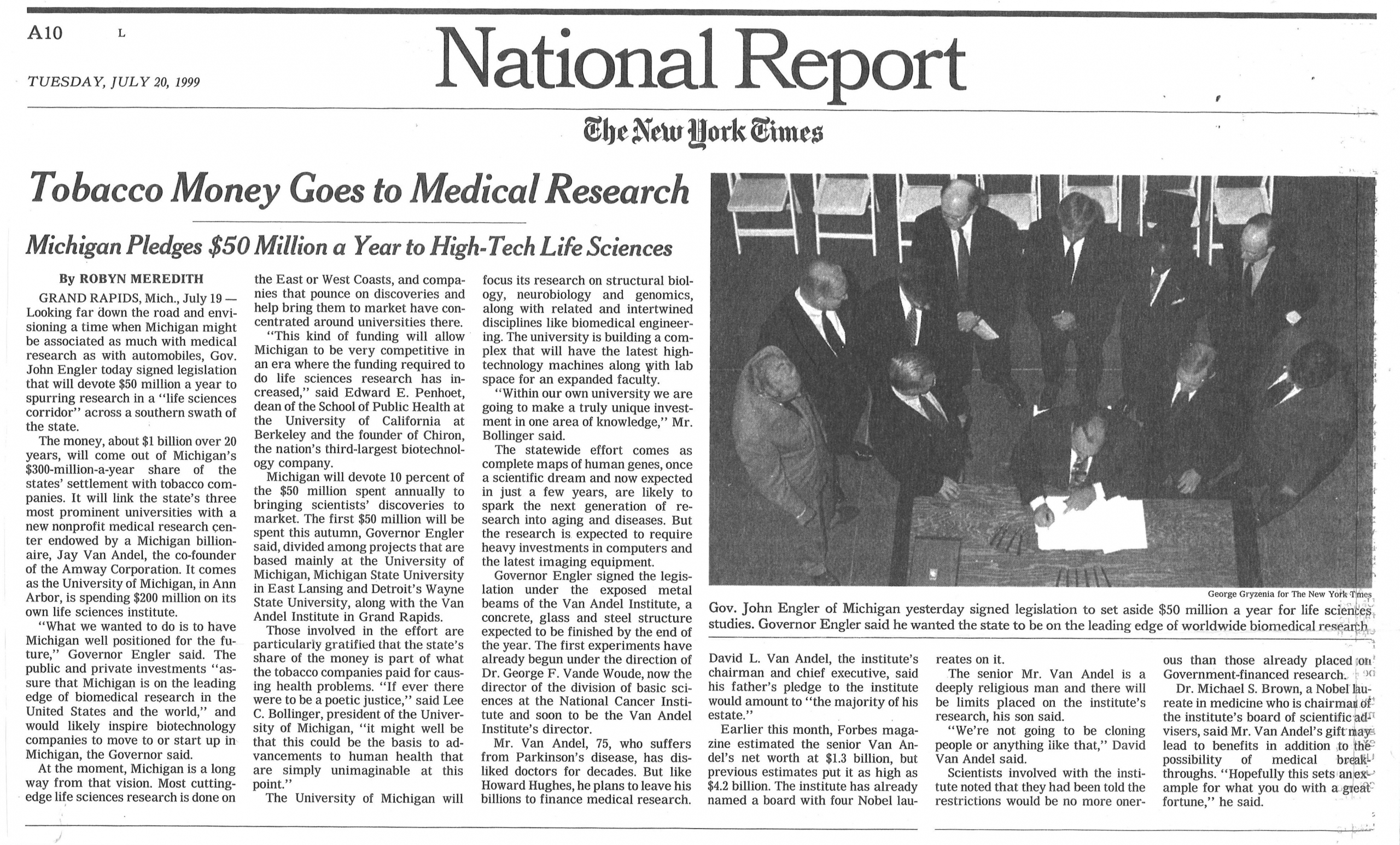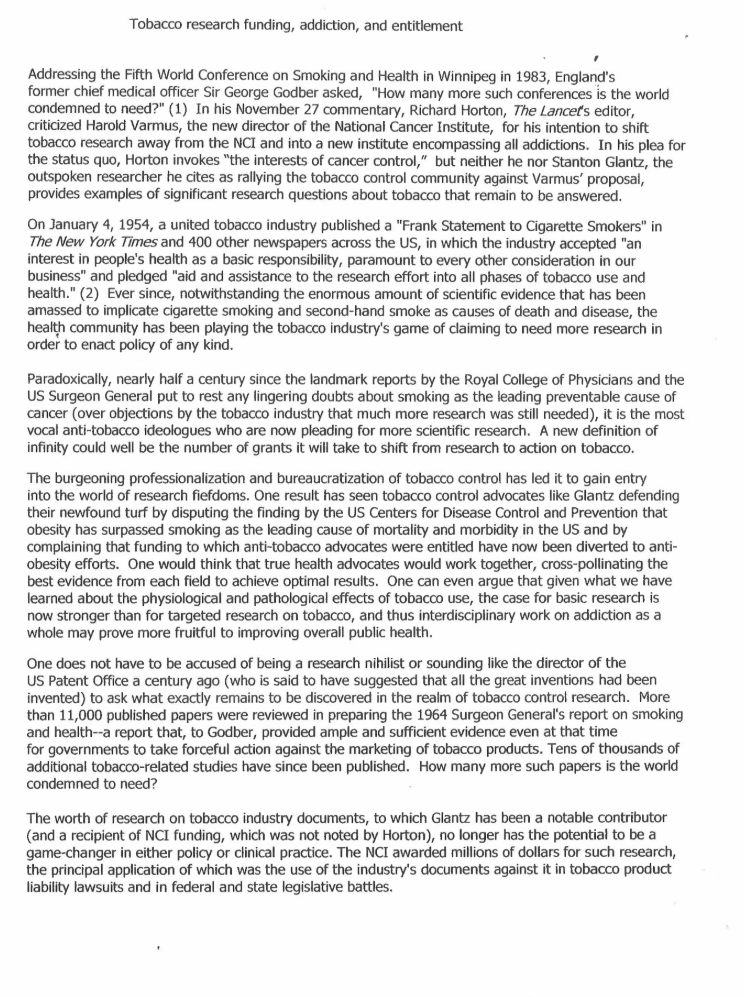Universities and Tobacco:
The Ties That Blind
Past and Present Relationships Between Academia and Cigarette Manufacturers
Appendix
Supplemental items that relate to conferences and courses that have addressed the relationships between universities and the tobacco industry, as well as articles about the ongoing debate on the ethics of the acceptance of tobacco industry funding by universities.
“Ongoing Relationships Between the Tobacco Industry & Universities: An Insidious Obstacle to Tobacco Control”
Flyer designed by Kevin Bailey for a presentation given by Alan Blum, MD at the National Conference on Tobacco or Health, Minneapolis, August 28, 2019.
Preliminary Exhibition Key for “Universities and Tobacco,” 2016 (15 pages)
“Ongoing Relationships Between the Tobacco Industry and Universities: An Insidious Obstacle to Tobacco Control” (15 pages)
Abstract by Alan Blum, MD for a presentation at the National Conference on Tobacco or Health in Minneapolis, August 2019 (first page, plus 14-page annotated outline for both the presentation and an exhibition)
“HARVARD SCHOOL OF PUBLIC HEALTH
COURSE DESCRIPTION FORM:
‘Approaches to International Tobacco Control’
Drs. Michael Reich and Gregory N. Connolly” (14 pages)
November 7, 1990
“Prepares students to apply training in epidemiology, statistics, management and policy for development of comprehensive public health programs to curb tobacco use. Concepts and techniques for measuring smoking prevalence, attributable mortality and economic costs are taught. Tobacco industry global structure, marketing, political strategies and world expansion are discussed. Guest speakers describe health policy and program interventions, including taxation, marketing restrictions, protection of nonsmokers, public education, litigation, and cessation programs…”
Curator’s Note: This course is believed to be the first on tobacco control at any school of public health. Dr. Connolly directed the Harvard School of Public Health’s Global Tobacco Control Program, served as the director of the Massachusetts Tobacco Control Program from 1985 to 2004, and was Professor of Public Health at Harvard/Chen School of Public Health from 2004 to 2014.
“Tobacco Studies in Public Health and Tobacco Scholars Program
University of Washington
School of Public Health and Community Medicine” (10 pages)
Description of two innovative efforts by family physician Abigail Halperin, MD, MPH, principal investigator, and Sara Savage, MPH, project manager, to develop curricula in the School of Public Health to address tobacco problems and to offer scholarships to students pursuing tobacco studies. The projects were funded from 2002-2006 by the American Legacy Foundation through a competitive grant initiative, STEP-UP (Scholarship, Teaching and Education Program for Tobacco Use Prevention), administered by the Association of Schools of Public Health.
Curator’s Note: Halperin’s and Savage’s courses and programs in tobacco control for over 15 years have left a rich legacy that continues in the University of Washington Tobacco Studies Program. Other pioneering courses in this field include those of Jasjit Ahluwalia, MD, MPH at the University of Kansas School of Medicine in 1995 (“Tobacco: The 20th Century Pandemic; Ruth Malone, RN, PhD, at the University of California, San Francisco School of Nursing from 2002 to the present (“Tobacco Control Policy Issues”); and Gary Giovino, PhD, at the University of Buffalo School of Public Health and Health Professions from 2008 (“Tobacco Control”).
“A FRANK STATEMENT TO CIGARETTE SMOKERS” (2 pages)
Advertisement by the Tobacco Industry Research Committee (comprised of the major cigarette manufacturers), Empire State Building, New York, New York
Indianapolis News (the advertisement was also published in more than 300 other daily newspapers across the country, as well as in tobacco industry trade publications)
January 4, 1954
“A Frank Statement to Cigarette Smokers”
Advertisement by the Tobacco Industry Research Committee
THE TOBACCO LEAF (tobacco industry trade weekly; the advertisement was also published in 335 daily newspapers across the U.S.)
January 9, 1954
“Distinguished authorities point out:
That medical research of recent years indicates many possible causes of cancer.
That there is no agreement among the authorities regarding what the cause is.
That there is no proof that cigarette smoking is one of the causes.
That statistics purporting to link cigarette smoking with the disease could apply with equal force to any one of many other aspects of modern life. Indeed the validity of the statistics themselves is questioned by numerous scientists.
“…We accept an interest in people’s health as a basic responsibility, paramount to every other consideration in our business.
“We believe the products we make are not injurious to health.
“We always have and always will cooperate closely with those whose task it is to safeguard the public health .
“For more than 300 years tobacco has given solace, relaxation, and enjoyment to mankind. At one time or another during those years critics have held it responsible for practically every disease of the human body.one by one these charges have been abandoned for lack of evidence…
“Many people have asked us what we are doing to meet the public’s concern aroused by the recent reports. Here is the answer:
“1.We are pledging aid and assistance to the research effort into all phases of tobacco use and health. This joint financial aid will of course be in addition to what is already being contributed by individual companies…”
“Sloan-Kettering Contributions”
Inter-office memorandum from James C. Bowling to C. H. Kibbee
November 23, 1964
Identified in the Truth Tobacco Industry Documents
https://www.industrydocuments.ucsf.edu/tobacco/docs/#id=jppp0124
Curator’s Note: Bowling (1928-1997) worked for Philip Morris from 1951 to 1986 was Director of Public Relations at the time of this memo (he later became chairman of the company); Kibbee was Secretary of Philip Morris. Joseph Cullman III (1912-2004) was president and ceo.
“The Contributions Committee recommended on November 8, 1962 that the company contribute $25,000 annually for a period of three years beginning in 1963 and subject to a review in succeeding years…
“Following the initial Philip Morris gift to Sloan-Kettering, R. J. Reynolds, The American Tobacco Company, Liggett & Myers, P. Lorillard and Rothman’s (Canada) have all made substantial contributions…
“Sloan-Kettering is clearly the premier institution in Cancer Research. The public, governmental agencies, and the medical and scientific communities give special credence to Sloan-Kettering communications and research direction. Sloan-Kettering’s interest in the virus theory of cancer causation, for example, has had great influence on both public and scientific attitudes.
“Dr. Frank Horsfall, Jr, Director of Sloan-Kettering Institute, has publicly expressed his doubt that smoking is implicated in carcinoma causation . Dr. Horsfall’s opinion (coupled with his demonstrated liking for our Marlboro cigarettes) has been beneficial. As head of the nation’s principle [sic] cancer research organization, he has tremendous influence…
“The industry earlier was made keenly aware of Sloan-Kettering’s influence when Sloan-Kettering researcher, Ernst Wynder, (Ph.D.) led the anti-cigarette attacks. He exploited his Sloan-Kettering association to the industry’s distinct disadvantage…
“In the fall of 1962, Dr. Horsfall and other Sloan-Kettering officials including Public Relations Vice President Carl Cameron began subjecting Wynder to more rigorous screening procedure before letting him speak in the name of the Institute. This has had a proper and pleasing effect.
“I would strongly recommend that we continue our support of Sloan-Kettering. It is consistent with our publicly stated desire to support efforts to find the answers to the vexing cancer problem. The deductible contribution to Sloan-Kettering is probably the most effective of all health research contributions.”
“COMING MEETINGS” (4 pages)
Memorandum by Leonard Zahn (1923-2016), public relations operative for The Council for Tobacco Research (CTR) from 1955 to 1994
September 23, 1981
Identified in the Truth Tobacco Industry Documents
https://www.industrydocuments.ucsf.edu/tobacco/docs/#id=gpww0044
Curator’s Note: Zahn used his press credentials as a member of the National Association of Science Writers to gain entry to medical conferences and to gather intelligence on researchers and science writers alike. This document epitomizes his modus operandi (and the strategy of CTR), namely, to catalogue all known and theoretical causes of cancer (and other smoking-related diseases), in order to downplay cigarettes as the leading avoidable cause of death.
“‘Journalist’ Conned Colleagues for 35 Years as Spy for Tobacco” (10 pages – click here)
Investigative report by David Zimmerman, editor and publisher
PROBE
April 1, 1999
“ICCCR Participants Honor Cullen,
Savagely Attack Tobacco Industry” (2 pages)
News article
The Cancer Letter
March 15, 1991
“The recent ICCCR (International Council for Coordinating Cancer Research) International Conference on Cancer Prevention was dedicated to the memory of Joseph Cullen, world leader in cancer prevention whose most important and far-reaching contribution was leading the federal government’s campaign against tobacco abuse.
“The conference, held at NIH’s National Library of Medicine, featured a savage attack on the ‘tobacco cartel’ for ‘exporting death’ to third world countries and for targeting advertising and promotional efforts to youth, minorities, and the poor…..
“Alan Blum, assistant professor of family medicine at Baylor College of Medicine, blasted the tobacco industry for its advertising and promotional policies and the media companies which accept it.
“He also criticized NCI, which he said has ‘failed abysmally to look at the tobacco industry’…
“‘Tobacco companies continue to provide research funding to medical schools, as if to imply that more research is necessary to settle what the industry calls the smoking and health ‘controversy.’…”
ADDITIONAL ARTICLES RELATED TO “THE BURNING TOBACCO QUESTION” IN THE LAST SECTION (7 pages)
“Playing with smoke, but not without fire”
Commentary by Richard Horton, Editor
The Lancet
June 29, 1996
“It would be naive to deny that the company’s [Philip Morris’] support for medical research has a dual motive…But as drug-company sponsorship amply proves, the pursuit of ideological purity in medical research is a nonsense…”
*****
“Tobacco firm’s gift starts row”
Article by Clare Garner
The Independent on Sunday (London)
July 21, 1996
“The Cancer Research Campaign is threatening to withhold future funding from Cambridge University after its decision to accept a £1.6 million gift from the world’s second largest tobacco company…
“Members of the university’s parliamentary body, Regent House, last week voted by 1,128 votes to 583 in favour of the controversial Sir Patrick Sheehy Professorship on International Relations, named after BAT’s [British American Tobacco] retiring chairman…”
*****
“UK MRC [Medical Research Unit] and Cambridge inhale tobacco profits”
Article by Sarah Ramsay
The Lancet
September 7, 1996
“The Sunday Times… revealed that work at the Neurochemical Pathology Unit in Newcastle is being sponsored by BAT Industries, owner of British American Tobacco… MRC head of public communications Mary Rice, who was quoted as saying ‘I didn’t think the funding could be justified,’ is now on paid leave and has been advised by the MRC not to take any more calls from the media…”
*****
“Public opinion sought on UK tobacco money”
Article by Jane Bradbury
The Lancet
October 5, 1996
“The UK cancer charity, the Cancer Research Campaign announced…that it is commissioning a major new study on public knowledge and attitudes toward tobacco and the tobacco industry. The CRC also intends to develop a code, in conjunction with the institutions it funds, to ensure that ‘Campaign grants and intellectual scientific property are not tainted with tobacco money’…”
*****
“Tobacco money, the BMJ, and guilt by association”
Editorial by Steven H. Woolf
BMJ USA
July 2003
“The integrity of research depends on trust — that the methods described were followed and the data are complete and undistorted. It would be foolish to trust tobacco companies, which have knowingly promoted a product that kills its users. But can we trust researchers who accept tobacco money, or the journals that publish their work? How far does guilt by association extend?”
*****
“More misleading science from the tobacco industry
Delaying clean air laws through disinformation”
Commentary by Michael J. Thun
BMJ USA
July 2003
“…ACS (the American Cancer Society) does not endorse of agree with the methods and conclusions of the study by Enstom and Kabat. ACS once collaborated with Enstrom, beginning in 1989…The acknowledgments at the end of the article thank two former ACS vice presidents for this assistance but fail to mention that ACS terminated its collaboration with Enstrom several years ago because of his unwillingness to address fundamental methodological problems with this and other analyses. At no point did Enstrom inform ACS that he had communicated with Philip Morris…or that he had applied for and received funding from Philip Morris…”
[Curator’s Note: James Enstrom, a retired epidemiologist at the University of California, Los Angeles (UCLA) School of Public Health and Jonsson Comprehensive Cancer Center. Enstrom was an epidemiologist at UCLA who conducted studies on the effects of tobacco smoke on human health. After UCLA his employment in 2010 claiming that his research did not align with the university’s academic mission, Enstrom and UCLA reached a settlement in which he was given permission to use the term “retired researcher.” Source: https://en.wikipedia.org/wiki/James_Enstrom]
“Tobacco Money Goes to Medical Research
Michigan Pledges $50 Million a Year to High-Tech Life Sciences”
Article by Robyn Meredith
The New York Times
July 29, 1999
“GRAND RAPIDS, Mich. July 19 — Looking far down the road and envisioning a time when Michigan might be associated as much with medical research as with automobiles, Gov. John Engler today signed legislation that will devote $50 million a year to spurring research in a ‘life sciences corridor’ across a southern swath of the state.
“The money, about $1 billion over 20 years, will come out of Michigan’s $300-million-a-year share of the states’ settlement with the tobacco companies. It will link the state’s three most prominent universities [University of Michigan, Michigan State University, and Wayne State University] with a new non profit medical research center endowed by Jay Van Andel, the co-founder of the Amway Corporation…
“Those involved in the effort are particularly gratified that the state’s share of the money is part of what the tobacco companies paid for causing health problems. ‘If there ever were to be a poetic justice,’ said Lee C. Bollinger, president of the University of Michigan, ‘it might well be that this could be the basis to advancements to human health that are simply unimaginable at this point.’
“…Mr. Van Andel, who suffers from Parkinson’s disease, has disliked doctors for decades. But, like Howard Hughes, he plans to leave his billions to finance medical research.”
Curator’s Note: According to the American Lung Association, which has issued an annual State of Tobacco Control Report Card for each state and the District of Columbia [DC] since 2002, Michigan is one of 41 states and DC to receive an overall grade of F. The percentage of state funding for tobacco control programs ($4.605,900) is just 1.53% of the $300 million annual payment the state receives from the tobacco industry as part of the Master Settlement Agreement. Additional federal funding brings the total to $6,953,539, which is 6.3% of the $110,600,000 that the Centers for Disease Control and Prevention estimates Michigan needs to become an effective tobacco control and prevention program. Meanwhile, the state collects more than $1 billion a year in tobacco-related revenue, primarily from its $2 a pack cigarette tax.
“Tobacco research funding, addiction, and entitlement” (2 pages)
Response by Alan Blum (submitted but not accepted for publication) to the Comment in The Lancet, November 27, 2010 by editor Richard Horton, editor, in which Dr. Horton echoes the criticism by tobacco control researcher Stanton Glantz, PhD, of a proposal by National Cancer Institute (NCI) director Harold Varmus to shift most tobacco control research from the NCI to a new addictions institute.
Horton: “Harold Varmus may have made an uncharacteristically ill-judged start at the National Cancer Institute. A plan to take most tobacco control research out of NCI and place it into a new addictions institute has understandably around anger in the tobacco control community. In a letter to Francis Collins (the Director of NIH) on Nov. 17, Stanton Glantz writes that such a move will create the appearance and reality of NCI walking away from tobacco. Worse, it will send a strong message that NCI does not think that tobacco control research is a priority for cancer control.”
Blum: “Addressing the Fifth World Conference on Smoking and Health in Winnipeg in 1983, England’s former chief medical officer Sir George Godber asked, ‘How many more such conferences is the world condemned to need?’ In his November 27 commentary, Richard Horton, The Lancet’s editor, criticized Harold Varmus, the new director of the National Cancer Institute, for his intention to shift tobacco research away from the NCI and into a new institute encompassing all addictions. In his plea for the status quo, Horton invokes ‘the interests of cancer control,’ but neither he nor Stanton Glantz, the outspoken researcher he cites as rallying the tobacco control community against Varmus’ proposal, provides examples of significant research questions about tobacco that remain to be answered.
“On January 4, 1954, a united tobacco industry published a ‘Frank Statement to Cigarette Smokers’ in The New York Times and 400 other newspapers across the U.S., in which the industry accepted ‘an interest in people’s health as a basic responsibility, paramount to every other consideration in our business’ and pledged ‘aid and assistance to the research effort into all phases of tobacco use and health.’ Ever since, notwithstanding the enormous amount of scientific evidence that has been amassed to implicate cigarette smoking and second-hand smoke as causes of death and disease, the health community has been playing the tobacco industry’s game of claiming to need more research in order to enact policy of any kind.
“Paradoxically, nearly half a century since the landmark reports by the Royal College of Physicians and the U.S. Surgeon General put to rest any lingering doubts about smoking as the leading preventable cause of cancer (over objections by the tobacco industry that much more research was still needed), it is the most vocal anti-tobacco ideologues who are now pleading for more scientific research. A new definition of infinity could well be the number of grants it will take to shift from research to action on tobacco…
“One does not have to be accused of being a research nihilist or sounding like the director of the U.S. Patent Office a century ago (who is said to have suggested that all the great inventions had been invented) to ask what exactly remains to be discovered in the realm of tobacco control research. More than 11,000 published papers were reviewed in preparing the 1964 Surgeon General’s report on smoking and health–a report that, to Godber, provided ample and sufficient evidence even at that time for governments to take forceful action against the marketing of tobacco products. Tens of thousands of additional tobacco-related studies have since been published. How many more such papers is the world condemned to need?…”
“Tobacco control: all research, no action” (2 pages)
Commentary by Alan Blum and Ransome Eke
The Lancet
June 19, 2021
“How to tackle the global smoking pandemic has become a perpetual dilemma. Tobacco control — a term adopted by 1990s academia to keep radical antismoking activism at arm’s length — remains mired in descriptive research that generates data to support policies aimed at reducing smoking. However, unlike, for instance, mosquito control, the vector — the tobacco industry– survives and thrives. And, like a mutating virus, it adapts to legislative and regulatory attempts to hinder the sale, promotion, and use of its products…
“The vaunted 1998 Master Settlement Agreement between the US state attorneys general and the tobacco industry, ostensibly to recover medical costs for disease caused by smoking, epitomises government addiction to tobacco money. States have spent only 3% of the annual payments to them from the industry to fight smoking, which in some instances is less than before the Master Settlement Agreement…
“The tobacco industry’s never-ending plea that more research is needed before restricting or banning its products has been heeded for too long. In 1985, US Surgeon General C Everett Koop pointed to the overwhelming scientific base — already more than 50 000 studies — linking smoking to various chronic diseases. A PubMed search on May 20, 2021, using the terms ‘smoking’, ‘cigarettes’, ‘tobacco’, and ‘e-cigarettes’ yielded 358,858 publications since Jan 1,1985. Are all these additional papers, and their funding, still insufficient?
“…Forget health ministers, legislators, and university trustees. Any hope for ending the tobacco pandemic lies in the commitment of every health professional to make smoking prevention, smoking cessation, and relapse prevention top priorities. Philanthropic foundations can best support this goal by shifting funds from research to hard-hitting, paid, mass media campaigns that indict tobacco companies, shatter myths (eg, that the filter makes smoking safer), and subvert cigarette sales through brand-name satire.”

